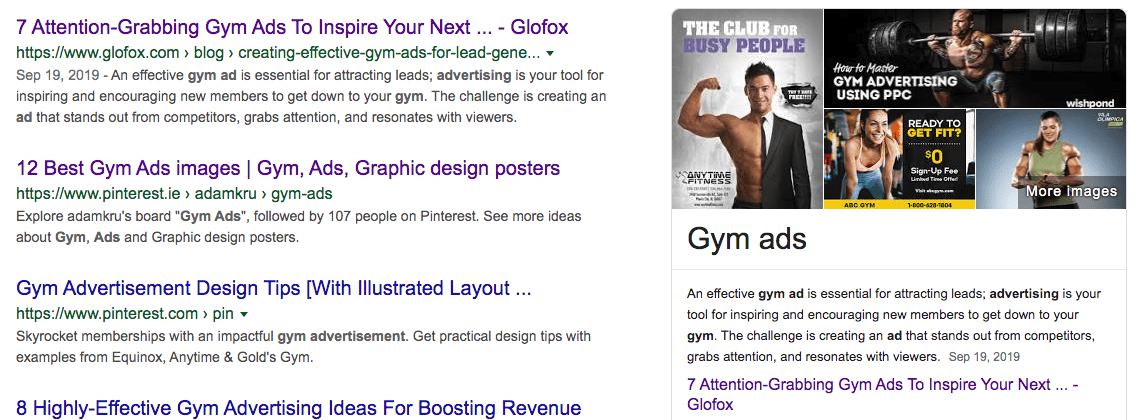The International Health, Racquet & Sportsclub Association (IHRSA) estimates the fitness industry will rack up close to $100 billion this year and $106 billion in 2020.
While the industry is booming, it’s also hugely competitive. To stand out with your fitness marketing in today’s world, you need to make the most out of fitness SEO keywords.
In this article, we’ll dive into how to bring potential customers straight to your fitness business with them. Skip ahead to:
Skip ahead to:
- What Is SEO?
- The Best SEO Strategy for a Fitness Business
- 5 Steps to Create Quality Content With Fitness SEO Keywords
What is SEO?
SEO stands for Search Engine Optimization. The idea is to generate organic traffic to your website by ranking high on search engine results.
For your fitness business, this means creating high-quality website content based on terms that your potential members will be searching for.
Say you own a fitness club in New York City. Prime location, sure, but also plenty of competition. You focus on good old print-based advertising. Flyers are strewn all over city streets, plastered on windshields. Maybe you use social media, Facebook ads, Google ads, and other paid digital marketing techniques.
These tactics are useful – and effective when done well. But smart marketing doesn’t rely solely on paid advertising.
Using original online content containing fitness SEO keywords is a great way to boost your website traffic and increase brand awareness – and the best part is it’s free.
However, you’ll need the right SEO strategy to convert those new organic visitors into actual, revenue-generating customers.
The best SEO strategy for a fitness business
Regardless of what fitness services you offer, you need a strategy if you want to attract new members with your fitness SEO keywords.
Your key objective will focus on ranking on Google for specific search terms – you just need to figure out the best way to get there.
Aside from driving traffic with SEO, you also need to convince visitors to get down to your studio. After all, you’re running a business – what good is having a bunch of website traffic if it doesn’t convert into paying members?
According to Econsultancy, the global conversion rate for the health and fitness industry is 1.5%. Because the whole idea of a business is to generate revenue and make a profit, some believe most of your budget – and thus your strategy – should focus on boosting your conversion rate. Others believe that increasing traffic to your website is the way to go because the more visitors you get, the more likely you are to acquire new members.
Both sides are actually right, and so there is probably a more balanced approach here that doesn’t require over-thinking these points.
Turning your website visitors into actual members is, of course, the goal. But you’ll need to increase your website traffic to do this – so that is also the goal.
Attract the right visitors
Your SEO strategy should focus on driving the right kind of traffic to your website, because:
- Not all traffic is good for business.
- Quality visitors will boost conversion rates.
So, who is the right kind of visitor?
- Your target audience. The fitness industry segment that’s most likely to purchase what your fitness business is offering.
- People in your area. They’re located in the same area as your fitness business.
The whole idea should be to turn relevant searches into organic traffic for your fitness website. To do this, you’ll need to know who your customers are, and what search terms they’re likely to use.
Create the right content
To rank on the first page of Google’s search results, you’ll need to create great content using the relevant fitness SEO keywords. And a significant part of convincing your target audience to visit your studio is to create engaging, useful content that answers their questions and makes you an authority on the topics covered.
Simply put: Your SEO content needs to be high-quality, helpful, and to match the intent of the user’s search.
For example, say you’re a Yoga Studio based in Hudson, New York. Your strategy is already successfully attracting the right people. Perhaps you have paid Google Ads running to help your website rank; a person who fits your target audience Googles “Yoga studios in Hudson New York” and your business comes up on the first page.
The Top 10 Barriers
Slowing Your Fitness
Business Growth
Discover more Organic SEO comes in a little differently. In this case, you want your fitness SEO keywords to focus on related content, i.e., other yoga-based topics that your target audience might be interested in.
It’s as simple as creating a variety of blog posts, like one being “best yoga pants in 2019”.
If your website has an article based on a list of the best yoga pants in 2019 – it’s useful to your customer, meets the intent that they are searching with, and will drive them to your website.
And in this case, it hasn’t cost you a penny to drive that potential new member to your site. But like any marketing strategy, creating SEO blog content isn’t something you plan on guesswork. In the next section, we’ll break down the steps you need to research and create great SEO content for your gym website.
5 steps to create quality content with fitness SEO keywords
1. Know your target audience
Successful marketing requires knowing your customers’ wants and needs. Your SEO strategy is no different. Make an effort to understand who your existing members are. From this, you’ll gauge an idea of who to target in the future. Here are some tips:
- Ask current members what they think about your classes and how you could improve to help better meet their needs.
- Check your customer data to determine who your typical member is – their age group and fitness preferences like the classes or services they participate in the most.
- Encourage member feedback. Use social media and email marketing to reach out to your members.
- Foster personal relationships with members to get more candid opinions.
With the insight you gain, you’ll have a clearer picture of who your current clients are, and how to retain them. This picture also reflects who your potential future customers could be.
You can then segment your target audience into a specific group and tailor your SEO content to appeal to them.
2. Conduct keyword research
Figuring out what keywords your potential clients are searching for is all about research.
Again let’s say you’re an NYC based yoga studio, and the bulk of your members are in their 50s and 60s. If you decide to target this segment as part of your SEO strategy, then you want to figure out what terms they’re likely to use. These terms will be made up of both short and long tail keywords.
Short tail keywords are non-specific terms that use one or two words, for example, “Yoga NYC”. Long tail keywords include more detail, such as ‘Yoga studio in NYC for 50-year-olds”
These examples are a good place to start with your competitive SEO research.
3. Suss out the competition
After coming up with the search term, look into how competitive it is to find the best focus keywords. This might be the most skill-heavy part of implementing your SEO strategy. The good news is that you don’t have to do it yourself – many competent SEO specialists offer their services on freelance websites such as Upwork and Freelancer.com at affordable rates.
But if you’d like to go it alone, there are some keyword tools available online – some free, some paid. Since we’re all about keeping costs low, here are some excellent free keyword tools:
Tolls like these enable you to see how much volume a keyword is generating – and what other websites are ranking for it. Once you have your keyword suggestions, it’s time to use them to create some high-quality, useful content that Google thinks your target audience will like.
4. Write high-quality, helpful content
The content on your fitness website should be as informative as possible. This doesn’t mean jam-packing your site with random articles and blogs on random pages without a plan. It doesn’t mean writing for writing’s sake or slapping fitness-related keywords sporadically throughout your blog.
What this means is that your content should be of high quality – distinct blogs and articles that will answer your potential clients’ specific questions. A high-quality blog should focus on your fitness SEO keyword. Also, make use of the related keywords suggested by your keyword tools. Here’s a basic map for creating great content:
- Find your approach – a unique angle that gets your target niche interested.
- Use your focus keyword in the title when possible.
- Also, use it in the first paragraph – if you can plug it into the first sentence in a way that reads naturally.
- Use your related keywords throughout the body of your article, but don’t overdo it – the piece should read easily and be engaging.
- If you include images, use Alt-text descriptions that include your keywords. For example, for a blog focused on the keyword’ yoga retreats’, insert your alt text as “yoga-retreats”. (Alt-text always requires a hyphen between each word).
- Write naturally, engage your readers, and answer your readers’ questions – search engines can tell when you throw keywords in there for the sake of it.
- Repeat the process for other blogs and articles – you should have multiple blog posts relating to different areas of fitness.
5. Include your keywords in your meta data
Metadata is the bow that ties it all together when publishing your article. This is what shows up on the search engine results page (SERP) as a description of your blog post.
It’s also what Google uses to give authority to your blog authority. This will include the title of the article and the meta description. The meta description is a short summary of a page that appears below the title in the Google results. Make sure to include your keyword in the meta description and the blog URL for best SEO practice.
If your article is well-optimized, Google will create a snippet preview of the piece – which is more likely to appeal to people who are searching for help on the topic.
The example below shows an insightful blog that ranks #1 for the term “Gym ads”.

In summary
Paid ads, both on and offline, are effective marketing techniques. But Optimizing your website with quality content that ranks high on search engines is a cost-effective way to attract visitors and essentially – acquire new members.














